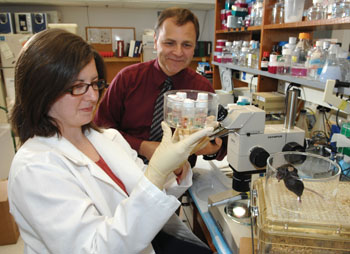
Joey Barnett, Ph.D., and fourth-year VUSM student Leigh Compton, Ph.D., examine mice embryos in the lab. (photo by Neil Brake)
Receptor helps build coronary blood vessels: study
Coronary artery disease — fatty plaques clogging the heart's supply lines — can produce chest pain or heart attacks, and is responsible for more than half of all cardiovascular disease in the United States.
Vanderbilt University Medical Center investigators have discovered a role for a growth factor receptor in the development of coronary blood vessels. The findings, reported recently in Circulation Research, may offer a new therapeutic target for directing coronary artery growth or repair, a possible alternative to bypass surgery.
It has become clear over the last decade that the coronary blood vessels are unique, said Joey Barnett, Ph.D., associate professor of Pharmacology and senior author of the new study.
They do not — as older textbooks suggest — branch from the aorta and grow to feed the embryo's developing heart. Instead, a small “packet of cells” near the embryonic liver migrates to the heart and coats its surface “like chocolate covering a strawberry,” Barnett explained. That coating becomes the heart's outer protective layer, the epicardium. Some of the coating cells invade the heart muscle and assemble the coronary vasculature. The vessels then attach to the aorta to complete the coronary circulation.
“The fact that these cells have a unique origin may explain why coronary arteries have certain types of disease pathologies, and might also provide us with new opportunities to fix these arteries,” Barnett said.
Barnett and colleagues have been pursuing how growth factors, in particular those in the TGF-beta family, participate in heart development. To examine the role of the “type III” TGF-beta receptor, Leigh Compton, Ph.D., a student in the Medical Scientist Training Program, knocked out the receptor gene in the mouse. Mice missing the type III TGF-beta receptor gene died in utero, at embryonic day 14.5, when functional coronary vessels are required for further development.
“It was striking that these mice don't make coronary blood vessels,” Barnett said. “Every other blood vessel we examined appeared to be present and normal, but not the coronary vessels.”
The findings suggest that the type III TGF-beta receptor plays a unique role in supporting coronary blood vessel growth, Barnett noted.
“And since more than 700,000 people in the United States will have coronary artery disease this year, identifying a molecule that's specifically required for coronary vessel formation is really exciting.”
Barnett's group had previously demonstrated in the developing chick that the type III TGF-beta receptor plays a role in heart valve formation. It was Compton's idea, he said, to pursue the mouse knockout.
“This is a perfect example of how graduate students lead us in our labs and teach us things; Leigh taught me about mice,” Barnett said.
The team continues to pursue the signaling pathways activated by the type III TGF-beta receptor, which has remained something of a mystery. It does not have the signaling regions that other TGF-beta receptors use to mediate TGF-beta's effects on cell growth and differentiation.
“We're beginning to identify molecules that specifically interact with the type III receptor, and as we understand more about its downstream signaling pathway, we will hopefully be able to use that information to manipulate coronary vessel formation or growth,” Barnett said.
Recent studies in zebrafish by other investigators have suggested that the adult epicardium retains the potential to form new coronary arteries — an encouraging sign that “tickling this receptor to re-initiate vessel growth might have therapeutic merit,” he said.
Other authors of the Circulation Research paper include Dru Potash and Christopher Brown, Ph.D. The research was supported by the National Institutes of Health and the American Heart Association.













